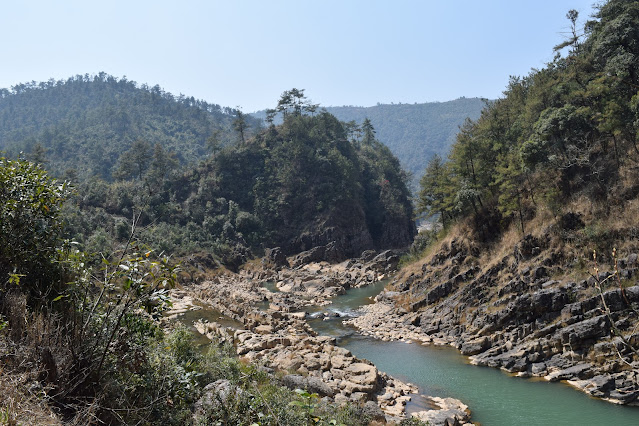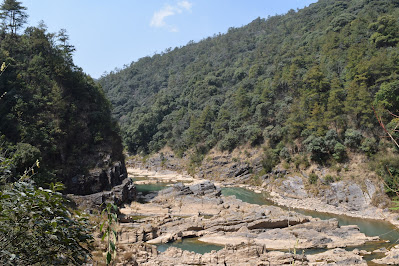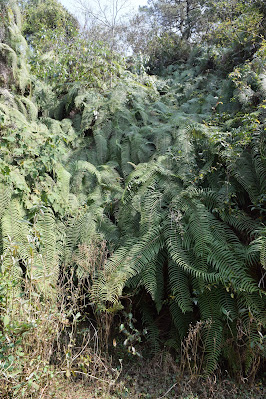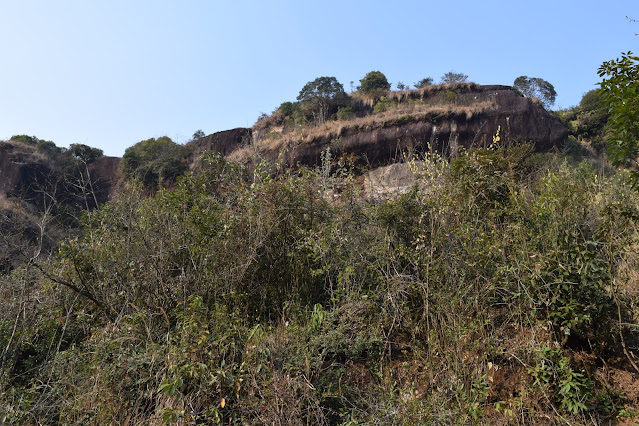Our view is of a sacred forest grove outside Mawphlang village. We are eight of us and a better hike group has never been assembled in human history (well, after Alexander anyway). There's Bob, our trek guide, about whom I should write a blog - sorry, a book - sometime. None of us can ever aspire to be Yul Brynner. Bob does not just aspire, he is Yul Brynner from The King And I, with his grin and corny Whatsapp humour and a head that last saw hair around the French Revolution. When he does not guide groups like ours, he loses money in cryptocurrency, but has theories to justify that (and everything). Serious.
Then there's the rest of us - mavericks, conformists, seekers, philosophers-after-gin-and-tonic, followers, vegans. A vegan can be a philosopher and seeker, I am informed, but Set Theory - the stuff where you do circles and intersections - was never a forte. I learn on this hike that there is a Set Theory of sorts at play with the Khasis and their sacred groves in Meghalaya too: a family could have Catholics and traditional believers, the new and the old, the real and, well, the ethereal.
The traditionalists believed in their spiritualism - though now in terminal, regrettable decline - a relic of symbolism and spirits that has ensured the preservation of its sacred groves, dolmens and stones of memory. This sacred forest in front of us - with a panoptic view of stunning rich green, radiating in the midday sun - is real and ethereal as well. Will it last, bearing the onslaught of religion? It is a dismaying thought but we must not worry about what we cannot control.....
(As an aside, and for your intellectual refurbishment, here is what the world's finest town newspaper has to say https://theshillongtimes.com/2016/01/07/the-traditional-religion-of-the-khasis/)
Mawphlang village has its clothes put out to dry - washing laundry is an obsession in Khasi-land. Some cultures have totem poles, Mawphlang has its laundry on a wire and its shoes - scrubbed white to blind - on a rod. Perhaps, as the Mahatma on the NREGA tablet will attest, the essence is the same.
We are in high spirits, following in the footsteps of David Scott who took this path - on his high horse, no doubt - to Sylhet in Bangladesh and then got it named after him (no, not Sylhet, but the trail). By all accounts, he was quite an odd fellow, which is true of all Scots who have ever existed- it's something to do with all that peated whisky that they have tucked in and the cold in Aberdeen (no one who is remotely normal could have invented golf).
As we descend into the valley - the gradual incline begins almost at once - the view of the forest is fetching and hypnotic: rich green interspersed with pink blossoms dot the hill on our right and the rolling hills go on and on. We are told by Bob that all of this land is in private hands or owned by a community. This beggars belief (well, for me anyway): these incredibly rich jewels of biodiversity owned by individuals who can do what they wish with it?
You see what I mean?
There is pine as well - the old villain of montane forests, that has destroyed native forests and implanted its monoculture to devastating effect. As we walk, we see denuded, deforested, sliced hillsides and I now have a part answer: where logging forests and getting the timber out is impossible, it's left alone. For the rest, there is much to be worried about. Cassandra - and timber contractors - would be in business here.
We stop by a lovely little stream to fill our bottles, soak our heads in its trickle and delay the hike. Streams like these are my raison d'etre and I dream of a life spent in a tent alongside their clear flow; but then, that moment is now. Those large shrubs could be small trees, or the other way around and those stones have much to tell us in their shapes.....they are meant to slow the water - and us - down.
Nothing like philosophy in verse. Or the inverse of philosophy.
 |
| Millie, gentle mystic, vegan, follower, leader-cum-feeder, cheese-maker. She carried so much food in from Bangalore that the excess baggage fare has lifted Indigo's quarterly profit estimates. |
We begin walking (a sentence that has inspired a dozen songs and a million Instagrammers who have no idea what it is - walking, that is, not Instagram). And, while we are in that valley, the forests envelop us in a warm, comfortable embrace.
 |
We walk past what seems like an invasive plant with pretty yellow flowers and landscapes of ferns, delicate and dainty and of use in local cuisine. Nothing could be more charming to see, tall trees on the sides and ferns in the folds, with trickles of water flowing by them. As with everything evolutionary, there is some magic at work here.
 |
| Now, this gets my goat |
This guy - the man on the side, not the goat above - has his priorities right. Basking in the sun, with a lazy line in the stream and that conical basket behind him to hold his catch. This basket must be a cultural totem (ignore those white shoes), for they are everywhere and used for everything: it isn't odd to see the occasional Khasi lady climb a hill with a baby peeping out of this wonder of a cone, the sturdy strap of which goes over her head. It is an image I grew up with in Digboi, filled with nostalgia of another day (as an aside, if you didn't already think of it, the goat has its priorities right too. Until it meets the butcher, that is).
........and immense deforestation that I have no wish to remember but needs to be recorded. The perils of private ownership of forests (or a pitch against capitalism in conserving them) is hardly a subject for intellectual discussion on this walk. It is QED - quod erat demonstrandum - proven, in a way, beyond argument.

















